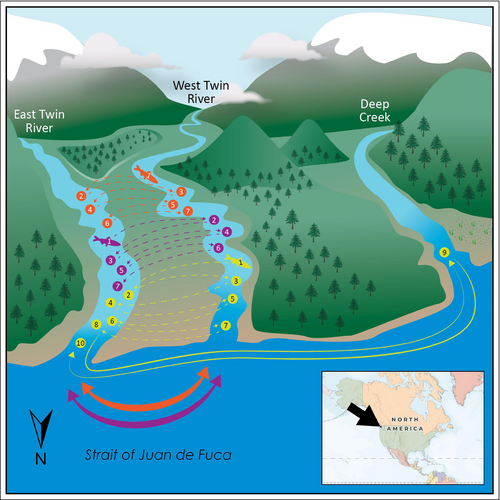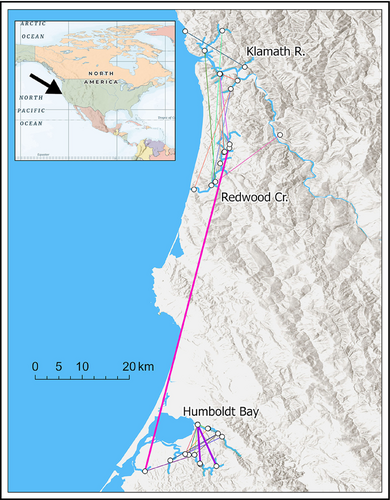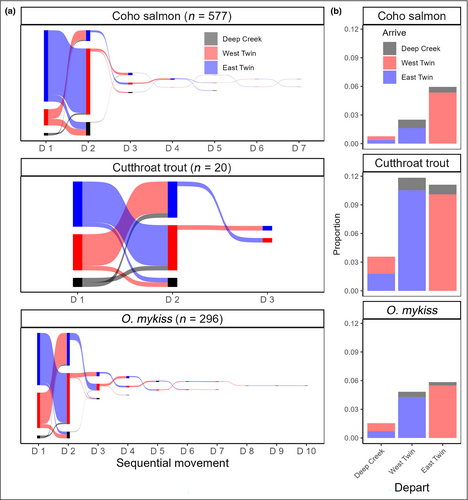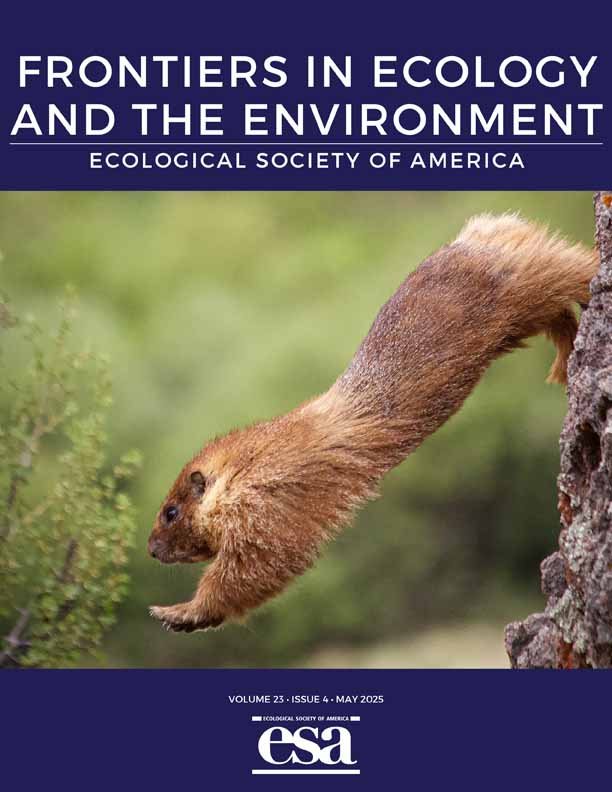Juvenile salmonids traverse coastal meta-nurseries that connect rivers via the sea
Abstract
Conventionally, juvenile salmonids are thought to migrate unidirectionally from freshwater systems to marine systems and therefore only inhabit natal drainages. Although scattered evidence suggests juveniles can move bidirectionally between freshwater rivers and the ocean, including into non-natal drainages, such movements have never been documented with high replication. Here, we detected hundreds of movements of juvenile salmonids between drainages that involved 0–22% of cohort emigrants in Washington State and California. Individuals moved up to nine times and between drainages up to 70 km apart. These findings reveal a life-history type of salmonids whose remarkably complex migrations have gone unnoticed. Implicitly, juveniles may use any coastal freshwater habitat accessible from the sea and may not descend from spawning populations of drainages they inhabit. Consequently, typical conservation focused on natal drainages may overlook freshwater habitat elsewhere. A concept of coastal areas as meta-nurseries formed by multiple watersheds connected by the sea may accurately describe anadromous species’ habitat options and better inform management.
Salmonids (family Salmonidae) exemplify our constantly evolving knowledge of migration. Oral traditions and writings indicate that people have long been intrigued by salmonids’ anadromy (Walton 1653; Conner 2019): that is, juveniles are born in streams, then migrate to the sea, and adults migrate back to spawn in their natal streams. Modern research has progressively uncovered surprisingly extensive and complex migrations, including juveniles that exploit entire landscapes before entering the ocean (eg Armstrong et al. 2013; Phillis et al. 2018; Brennan et al. 2019). Recognition of this mobility supports a common argument for habitat conservation beyond natal streams.
In contrast, both the idea that juveniles can swim through marine waters to access terrestrially unconnected drainages (referred to here as freshwater habitat networks with common ocean entry points) and the argument to scale-up habitat conservation accordingly are uncommon. Juvenile migrations between freshwater and marine systems are conventionally assumed to run in only one direction and thus involve only freshwater habitats that are within natal drainages. Notably, this perception implies that conservation of populations’ natal drainages encompasses the entirety of their freshwater rearing habitat.
However, clues from published and gray literature contradict this perception. To the best of our knowledge, biologists across Asia, Europe, and North America have documented 34 juvenile salmonids that exited a freshwater drainage, traversed salt water, and then entered a different drainage (Brenkman et al. 2007; Faukner et al. 2017; Taal et al. 2017, 2018; Kuroki et al. 2020). In addition, juveniles have been observed in, and swimming into, drainages that lack habitats or conditions that support reproduction (Koski and Lorenz 1999; Koski 2009; Beamer et al. 2013; Lambert and Chamberlin 2023).
These patchwork observations attest to a largely unnoticed life-history type. These juveniles migrate in two directions between freshwater and marine systems. They form migratory pathways that are much more complex than is presently recognized and could access freshwater habitats where people do not expect them to be. Nevertheless, this behavior remains obscure to biologists and practitioners. This is important because habitat conservation and restoration are prioritized according to where imperiled populations are thought to be. A novel perspective that reports persistent and highly replicated juvenile movements among drainages may close this knowledge gap.
Here, we report hundreds of such movements, up to nine times per fish and between drainages up to 70 km of saltwater shoreline apart. Most of these observations come from long-term monitoring in Washington State, but observations from California indicate this behavior happens elsewhere as well. By implication, juveniles may use virtually any coastal freshwater habitat that they can access from the ocean, including places where people have not thought to look. Conserving the full range of salmonid freshwater habitats will require updating and broadening the focus of protection and restoration beyond natal drainages. Freshwater rearing habitat does not end where natal drainages meet the sea. Instead, salt water provides paths for juveniles to move from one drainage to another and traverse coastal “meta-nurseries”.
Methods
Washington State
We monitored juvenile salmonids in Deep Creek, West Twin River, and East Twin River, which drain 45 km2, 32 km2, and 35 km2, respectively, of forested land along the Strait of Juan de Fuca, on the Olympic Peninsula of western Washington State (Figure 1; for more details, see Bennett et al. [2015]). Deep Creek is separated from West Twin River by 8.4 km and West Twin River is separated from East Twin River by 0.4 km. Human impacts to these drainages include logging and removal of large woody debris. Restoration projects took place before and during our study primarily in the vicinity of East Twin River, including road and culvert removal, placement of large woody debris, and riparian planting.

We monitored coho salmon (Oncorhynchus kisutch), steelhead/rainbow trout (Oncorhynchus mykiss), and cutthroat trout (Oncorhynchus clarkii). For brevity, we refer to rainbow trout and steelhead collectively as O mykiss, as they are the resident and anadromous forms of the same species and were phenotypically indistinguishable when tagged. We tagged and detected salmonids from 2004 to 2023. Juveniles were captured by electrofishing primarily from July to September. After capture, coho salmon >55 mm in fork length and cutthroat trout and O mykiss > 60 mm were implanted with 12-mm passive integrated transponder tags, the unique codes of which could be used to identify individuals. A total of 56,417 coho salmon (67 ± 11 mm [mean ± standard deviation]), 1766 cutthroat trout (123 ± 45 mm), and 31,720 O mykiss (83 ± 24 mm) were tagged, of which 27%, 12%, and 22% were redetected, respectively. The remainder were not redetected due to uncertain contributions of mortality, resident life histories, and imperfect tag detection. Tagged fish were detected remotely by antennas and manually at traps. Arrays automatically detected tags year-round 600 m, 300 m, and 100 m upstream from the mouths of East Twin River, West Twin River, and Deep Creek, respectively. In 2004, additional antennas were briefly placed in a tributary of the East Twin River; we consolidated observations from those antennas with observations from the other antennas in East Twin River. In addition, seasonal traps were built across the mouths of the three drainages to continuously intercept outmigrating fish from April to June. Traps were checked daily and captured fish were manually scanned for tags.
To minimize the possibility of reporting movements of individuals that had matured into spawners (that is, to focus on juveniles), we only examined movements of individuals that were tagged in July or later and observed in another drainage before July of the next year for coho salmon and before July of two years after tagging for cutthroat trout and O mykiss. The shorter timeframe for coho salmon reflects the tendency of this population to include occasional two-year-old spawners, whereas cutthroat and O mykiss typically spawn at older ages. Additionally, because juveniles were often detected numerous times as they swam past arrays, we did not present consecutive, redundant observations of individuals in the same drainage on the same day.
Because our sample size of observations was much larger in Washington than in California (described below), this allowed us to examine patterns in movements across time and space for fish in Washington but not California.
California
Roughly 730 km to the south of the studied area in Washington, we similarly captured, tagged, and redetected juvenile coho salmon (85 ± 20 mm) from 2012 to 2024 (Figure 2; for details, see Faukner et al. 2017; Halloran 2020). Most tagging involved 8934 juveniles in Redwood Creek and 20,485 juveniles in drainages that entered Humboldt Bay. We then redetected individuals in these locations, as well as in the Klamath River via antennas and manual scanning. Unlike sampling in Washington, sampling in California was not designed to persistently monitor movements at drainage mouths; consequently, detections in non-natal drainages were often a coincidence of uncoordinated sampling efforts. We therefore did not attempt to quantify rates of redetection or movement between drainages from these observations. Also, salmonid outmigration phenology typically occurs earlier at lower latitudes (Quinn 2018), which would further differentiate the sites in Washington and California; moreover, in California, a subset of juveniles were tagged during the winter and spring.

Results
Washington State
In Washington, we detected 893 juvenile salmonids that moved between drainages (Figures 1 and 3; Appendix S1: Figure S1a). This included 577 coho salmon, 20 cutthroat trout, and 296 O mykiss, which corresponded to 4%, 10%, and 4% of the total number of individuals of each species that we detected after tagging, respectively. Among individuals that moved between drainages, 92% moved between drainages once, while the remaining 8% moved repeatedly, up to nine times and across all three monitored drainages (Figures 1 and 3).

Movements ranged from brief forays to extended rearing. On 136 occasions, juveniles were detected in multiple drainages within a 24-hour period. In contrast, we detected 72 juveniles that moved between drainages during the calendar year in which they were tagged and were later detected the following calendar year in a drainage where they were not tagged (Appendix S1: Figure S2). That is, some fish appeared to rear in non-natal drainages over winter.
Movement among drainages was also seasonal, directional, and annually variable. Juveniles moved in and out of drainages year-round, with peaks near fall and spring (Appendix S1: Figure S1b). Movements were predominantly westward and between the two closer drainages (Appendix S1: Figures S1a and S3). Within years, species, and drainages when at least 25 individuals were tagged and redetected, 0–22% of coho salmon and O mykiss used more than one drainage (Appendix S1: Figure S4). This pattern of generally westward movement—evidenced by greater proportions of individuals detected in multiple drainages that were originally tagged in drainages farther east—generally held over time (Appendix S1: Figure S4).
California
In California, we detected 28 coho salmon that moved between drainages (Figure 2). Movements tended to occur between closer drainages. Many of these shorter movements traversed Humboldt Bay, including by one juvenile that moved twice between drainages. However, some movements were over much longer distances. For instance, one juvenile moved from Prairie Creek, a tributary of Redwood Creek, to Martin Slough, a drainage that feeds into Humboldt Bay, and therefore swam at least 70 km south along the Pacific shoreline.
Conclusions
Juvenile salmonids can move from one drainage to another. They not only migrate out of, but also into, multiple drainages and thus inhabit non-natal drainages. Movements range from brief forays to overwinter rearing and take place across very different coastal settings. Building on previous evidence, we confirmed the existence of a largely overlooked juvenile life-history type expressed by multiple salmonid species, which has been documented on three continents (Lambert and Chamberlin 2023). The back-and-forth migrations of these species between freshwater and marine habitats vastly expand our recognition of potential habitat ranges and connections.
Research has progressively demonstrated that juvenile habitats of anadromous fishes are more connected than conventionally thought. For example, DNA analyses confirmed that juvenile striped bass (Morone saxatilis) dispersed through marine waters into non-natal drainages, which accounted for how juveniles were found in rivers up to 450 km away from spawning areas (Robinson et al. 2004). Furthermore, in contrast to “textbook” migration whereby blueback herring (Alosa aestivalis) only return to freshwater habitats to spawn, otolith analyses revealed that immature individuals migrated alongside adults back and forth between rearing areas and the sea (Limburg and Turner 2016). These findings, in combination with those of salmonids summarized above, suggest that the full extent of habitat use by anadromous fishes is chronically under-characterized.
A concept of coastal areas as meta-nurseries may describe the true breadth of anadromous migrations and habitats. This concept considers coastal areas’ multiple drainages and the sea as a mosaic of connected habitats that collectively support reproduction and rearing. Analogous to a map of global shipping routes, a hypothetical map of juvenile migrations may show some well-traveled paths (eg away from spawning grounds) but also numerous paths throughout drainages (Phillis et al. 2018; Brennan et al. 2019), in and out of drainages over multiple years (Limburg and Turner 2016), and among separate drainages that need not support reproduction (this study; Robinson et al. 2004), altogether forming a remarkably complex constellation of possibilities.
We hypothesize that the capacity to support complex habitat use is beneficial. Diverse portfolios of coastal habitats whose quality varies asynchronously could offer alternatives to natal rearing areas when habitat conditions in natal streams are poor (Schindler et al. 2015; Brennan et al. 2019). Moreover, the disparate regimes of watersheds and oceans could allow juveniles to make the most of unevenly distributed conditions (eg predators, prey, temperature) by integrating across habitats (Armstrong et al. 2013). Species like salmonids often disperse when densities are high (Quinn 2018) and movement to other drainages could alleviate competition. Complex anadromous movements could not only enable juveniles to learn about surrounding areas—including by schooling with more experienced conspecifics—but also inform subsequent habitat use (Limburg and Turner 2016). Overall, there are many reasons why complex movements that bridge diverse habitat options could be advantageous.
Recognition that juvenile habitat can transcend natal drainages may inform conservation. Because adults usually spawn in natal streams, conservation efforts often categorize populations by watershed of origin, which may overlook freshwater habitat elsewhere. For example, O mykiss populations in our Washington study region were not listed under the US Endangered Species Act (ESA), but O mykiss populations in the nearby Elwha River were ESA-listed. Juveniles of listed populations could thereby migrate from the much larger Elwha River into our focal watersheds, which are thought to lack listed populations. Similarly, in our California study region, habitat restoration funds are preferentially allocated to high-priority populations, but populations’ designated habitat ranges do not transcend natal drainages (CDFW 2024). For example, restoration of the Klamath River and Redwood Creek watersheds is prioritized above restoration of Lagoon Creek, but juveniles from the former two occasionally use the latter. In addition, access to small coastal streams is often impeded by culverts and weirs. While adults may naturally be absent from smaller systems and people may thus assume salmonids are absent from them, these areas may still provide habitat to juveniles that undertake migrations. In general, a clearer understanding of juvenile movements may help managers revisit habitat conservation approaches and consider whether they address an appropriate range of habitats.
Questions remain for future research. A natural extension of our work would be to quantify the regional prevalence of individuals in drainages that originated elsewhere and understand factors that influence habitat connections. For instance, perhaps small coastal streams are often populated by juveniles that originated elsewhere when a much larger river enters the sea nearby (Beamer et al. 2013). It is also not known if genetically distinct portions of populations tend to use non-natal drainages, which could be relevant to conservation efforts that distinguish populations with different heritable life histories. Whether juvenile movements among drainages influence adult homing is also unknown. Typically, adults navigate to natal spawning grounds that they imprinted upon as juveniles (Dittman and Quinn 1996), but perhaps positive juvenile habitat experiences in non-natal drainages promote adult returns to non-natal drainages.
It is also unclear whether human stressors influence movements between drainages. Movements into non-natal drainages could allow juveniles to access alternatives to degraded natal habitats, as may happen when juveniles move extensively within some drainages (Phillis et al. 2018). However, we were unable to relate movement rates to drainages’ habitat states because sampling in California was sparse and differences in movements detected among sites in Washington may have simply reflected the spatial arrangement of monitored areas and primarily westward movements.
Relatedly, our study underestimated the true frequency and extent of juvenile movements. A limitation to our methods was that juveniles were detected only in select locations that were monitored. Juveniles could have entered unmonitored drainages or, in California, unmonitored parts of drainages. Moreover, juveniles could have migrated among monitored drainages during times when monitoring was not possible or when detection was impaired. For example, storms sometimes damaged arrays or created high river flows that allowed fish to swim above arrays’ detection ranges.
Migrations of juvenile salmonids are more diverse than has been previously recognized. Intriguingly, biologists continue to discover migratory behaviors even among salmonids, despite their migrations having been studied for centuries (Walton 1653). A meta-nursery concept that recognizes coastal areas’ multiple, connected habitat options may accurately characterize the natural histories of anadromous fishes like salmonids and inform conservation that seeks to address the true breadth of their habitats.
Acknowledgements
This project was funded by the Washington Department of Ecology, the California Department of Fish and Wildlife, the Bureau of Reclamation, and the National Oceanic and Atmospheric Administration. Access to study sites was provided by I Fausett, D Morse, J Paul, Merrill and Ring Inc, Rayonier Timber Inc, Redwood National Park, Save the Redwoods League, and the LaFarge Corporation. We are also grateful to members of the Lower Elwha Klallam Tribe, Weyerhaeuser Company, student interns, and volunteers for the immense amount of fieldwork required to maintain the Washington State monitoring program. We also thank C Anderson for overseeing tagging efforts in the Humboldt Bay tributaries and maintaining the associated tag and detection database and R Taylor for maintaining an antenna that detected the juvenile that moved ~70 km from its tagging site. We also thank J Chamberlin, M Pollock, and P Kiffney for critiques and insights that improved the manuscript, and S Kim for creating Figure 1.
Open Research
Data Availability Statement
Data (Munsch et al. 2025) are available on Figshare at https://bibliotheek.ehb.be:2102/10.6084/m9.figshare.28207904.v1.






